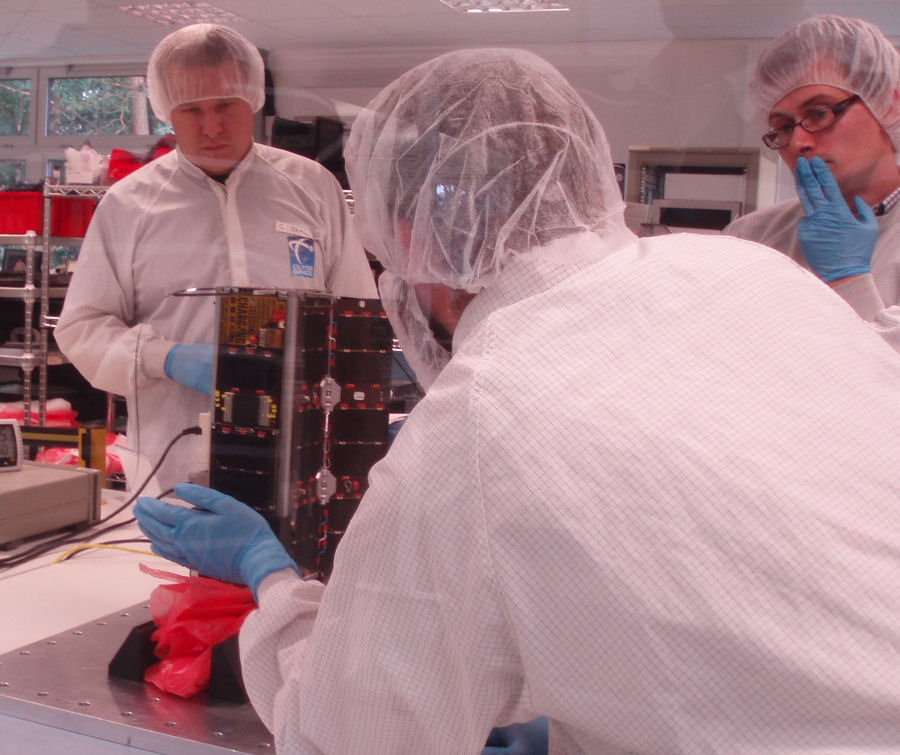RAL Space Involvement
Chilbolton Ground Station, ground support operations
Subject
Feasibility test
Main Objectives
To demonstrate the capability of useful science to be performed within a CubeSat sized spacecraft.
Launch Date
8th July 2014
Partners
UKSA, Technology Strategy Board, Clyde Space, University of Strathclyde, EADS Astrium Ltd, Bright Ascension, Invotec Group, Isotron
Further Information
AMSAT-UK
GOV.UK
Overview
The UKube-1 mission is an exciting collaboration between industry and academia, and is the pathfinder for a potential national CubeSat programme. It is hoped that this project will increase the UK’s ability to market new space technologies, as well as provide hands on experience for future scientists and engineers.
UKube-1 will fly six payloads built by UK industry and academia. The UKube-1 ground segment consists of Chilbolton ground station which will control the satellite, and the UKube-1 Mission Operations Centre (UMOC) at RAL. Following the successful launch on 8 July 2014, the ground station at the Chilbolton Observatory has received telemetry from the satellite.
The UKube-1 spacecraft remains healthy, the batteries and solar panels are in excellent shape and its attitude has stabilised so it is spinning very slowly.
Some issues have occurred achieving duplex communication and with the on-board computer resetting, which meant operational workarounds have had to be devised. The cause of the resets is still under investigation. A hybrid system was developed enabling the acknowledgements to commands to be captured using a different system, and operations using the payloads executed. Most of the payloads were operated successfully in most of their modes, and data (plus logs) downlinked for analysis.
The AMSAT community have been a great help in monitoring UKube-1 and this is gratefully acknowledged by the UKube teams and the UK Space Agency. The FUNcube-2 educational payload has been tested and can run at high power, which makes it easier for schools to capture data with a small aerial. AMSAT-UK will now use FUNCube-2 for education and outreach for a further 2 years.
Payloads
UKube-1 is a UK Space Agency technology demonstration satellite that will fly six payloads. The UKube-1 ground segment consists of Chilbolton ground station which will control the satellite, the UKube-1 Mission Operations Centre (UMOC) at RAL, and the Dundee Satellite Receiving Station which will collect the data from UKube-1 and forward it to the UKube-1 Mission Operations Centre (UMOC) at RAL.
The payloads:
- C3D - A compact CMOS camera demonstrator, with 2 cameras and a radiation damage monitor. Developed as a collaboration between the Open University and e2v.
- TOPCAT – Designed by the University of Bath TOPCAT will consist of a specialised dual-frequency GPS receiver suitable for operation in the space environment. It will be used to study space weather by observing the upper ionosphere and the plasmasphere.
- JANUS – an EADS Astrium payload developed to investigate random number generation via cosmic rays and investigate the Single Event Upset (SEU) effect on a Xilinx Virtex4 device.
- Mission Interface Computer (MIC) – a reconfigurable, high performance on-board computer provided by Steepest Ascent to support all telemetry and telecommand processing, platform operations, as well as providing on-board mass storage.
- STX – a compact S-band transmitter for CubeSats, developed by the Cape Peninsula University of Technology.
- FUNCUBE-2 – an educational project for radio, space, physics and electronics, designed to engage school pupils.
STFC's Involvement
 STFC’s Chilbolton Observatory (CHOB) has a wide range of dishes and antennae for communicating with satellites. UKube-1 will communicate with the UHF/VHF antennae, but data may be downlinked using the faster S-band transmitter (one of the payload experiments). It is also possible to monitor the health of the satellite using the information received from the FUNCube-2 payload. Much of the equipment which will be used during operations was taken to Clyde Space to support the operations rehearsals for Ukube-1.
STFC’s Chilbolton Observatory (CHOB) has a wide range of dishes and antennae for communicating with satellites. UKube-1 will communicate with the UHF/VHF antennae, but data may be downlinked using the faster S-band transmitter (one of the payload experiments). It is also possible to monitor the health of the satellite using the information received from the FUNCube-2 payload. Much of the equipment which will be used during operations was taken to Clyde Space to support the operations rehearsals for Ukube-1.
RAL Space has decades of experience in planning and preparing command files for satellites and will run the UKube-1 Mission Operations Centre (UMOC).The software which interfaces to the mission planning system is written by RAL Space. The mission manager designate, Dr Helen Walker, supported the operations rehearsals at Clyde Space; these demonstrated that the satellite and the software were ready for launch. Having a Mission Operations Centre, which can actively control the satellite and the payload activities means that payload parameters and the timing of their operations can be updated during the mission.
